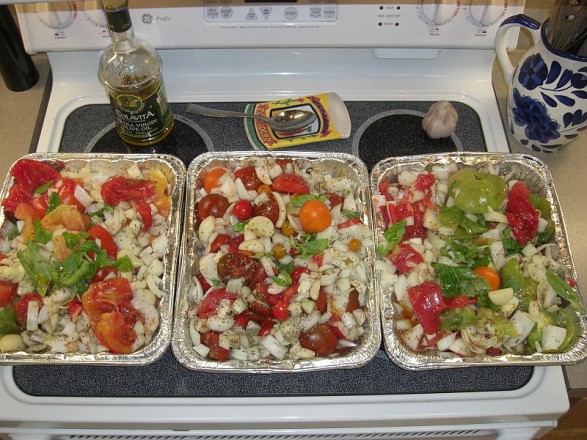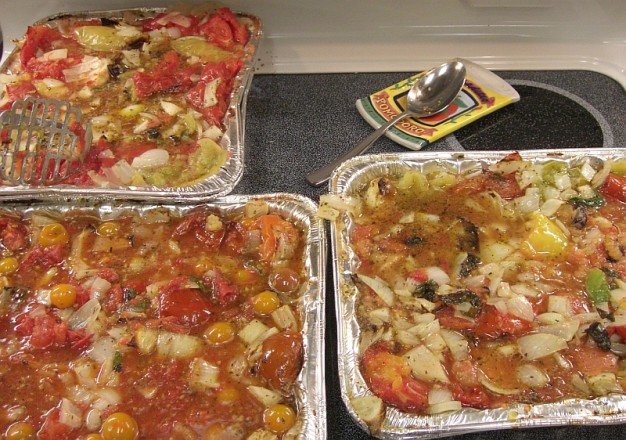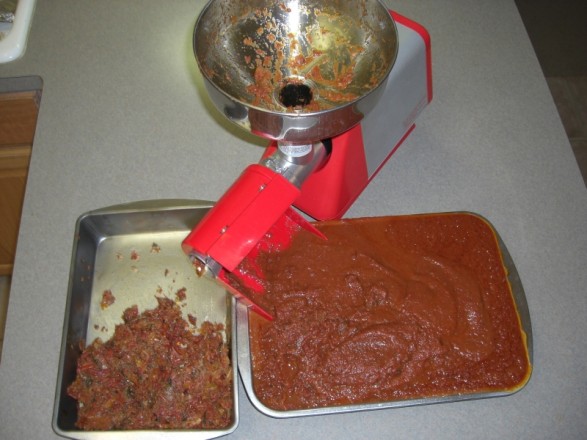I’ve been making a lot of oven roasted sauce lately. It’s an easy way to turn your excess tomato harvest into a tasty, rich sauce to enjoy throughout the year. I originally got the idea from critterologist on Dave’s Garden, who wrote an informative and detailed article about it there. She says it is “pure ambrosia”, and I agree! I’ll never go back to slaving over a hot stove top to cook down tomatoes into sauce again. This method frees up my time to get some other things done while the sauce is roasting, and tastes much better.
Any tomatoes you have on hand can be used. Meaty paste types are not necessary. Got a buildup of cherry tomatoes? Throw ’em in too.
The recipe is rather flexible, and has been modified slightly for my own preferences. I tend to use what is on hand if I have most of the ingredients and don’t have time or inclination to run to the store. When I made a batch last fall, I didn’t have onions, but plenty of garlic. So, I just doubled the amount of garlic (we really like garlic!) I’ve also made it without oregano and used more basil, added more peppers for a spicier sauce, etc.
I should add that based on reader feedback, if you put fresh basil or oregano leaves or other ingredients on the top like I have pictured, they can burn. It is probably best to combine everything by stirring a bit before you pop your pan(s) into the oven.
Here’s my basic recipe:
- 5-7 pounds of tomatoes, washed – halved or quartered depending on size
- 1 large onion, or two small – diced
- 18-25 garlic cloves, peeled
- 2-3 moderate heat peppers, jalapenos or similar
- 1/4-1/3 cup good quality extra virgin olive oil (I use Colavita)
- 2 Tbs of dried oregano or Italian seasoning – or fresh oregano if available
- 1-2 Tbs dried basil, or large handful of fresh basil
- Combine ingredients in roasting pan(s), and cook at 400 – 450F for 2 to 4 hours to desired consistency – larger batches may take longer
- Salt to taste – I don’t usually find the need to add salt
- Let cool and run through food mill
Peeling and deseeding tomatoes is not necessary. The original recipe suggests coring the tomatoes, but I don’t bother as my Spremy Electric Tomato Strainer does a great job at removing seeds, skin and cores. Be sure and cut off any bad spots, including severe cracking in case mold or bacteria is present.
I usually process several hundred pounds of tomatoes a year, so the Spremy was a great investment for me. However, if you are looking for a more affordable alternative (about $50), some who have tried this recipe say the OXO Food Mill works great too.
Note: If you don’t have a food mill, you can still make this sauce. I would recommend blanching and peeling the tomatoes first and removing the cores, though. Peppers would need to be diced – or use powder. Use a hand-held potato masher or food processor to break the roasted tomatoes up a bit. Finished product will be more chunky than what you would get by using a food mill, but is still delicious.
Tip: To quickly and easily peel the garlic, separate each bulb into individual cloves, and microwave on high for one minute between two paper plates (they may pop a bit, so don’t be startled.) Allow to cool for a few minutes before attempting to remove the clove covers, or you may burn your fingers. This will lightly “roast” the garlic and loosen the skins so that they slip right off. However, if you have a good quality food mill, you can likely throw in the garlic cloves without bothering to peel them first if you wish.
You will need to periodically check on the roasting tomatoes. I like to set a clip-on timer for about 45 min and take a look every time the timer goes off. Stir or mash occasionally to distribute the bottom layers to the top. You do want some light blackening of the cut tomato surfaces to occur, but not burning. The recommended temperature in the original recipe is 450F, but I sometimes roast at 400F so I can extend the time between checking/stirring while I am doing other things. As the sauce starts to really thicken up, you’ll want to pay more frequent attention.
Tip: I use a hand-held potato masher a couple of times during the roasting process, as it seems to speed things up a bit.
Roasted sauce can be made in small or large batches, just adjust the recipe accordingly. I prefer to make very large batches when my harvest starts to pile up, as it’s a quick way to clear oodles of counter space. I save a lot of seeds and like to combine my seed saving with sauce making whenever possible, so I don’t waste the tomatoes after extracting the seeds. Larger batches may take more time, hence the wide range of suggested cooking times. Cooking to a thick consistency will take longer, so will using the lower suggested temperature range.
This sauce is probably only safe to keep in the refrigerator for about 5 – 7 days tops. For longer term storage, put into freezer bags, label and lay the bags flat in a stack in your freezer. I’ve found that a quart sized freezer bag filled to about a 1″ thickness when laid flat is plenty for a dinner for two. Roasted sauce can be pressure canned, but the boiling water bath method is considered unsafe, mainly because of the olive oil. Consult the current Ball Blue Book or other authoritative canning guidelines for recommended times and procedures if you are considering canning the sauce.
35-40 pounds of tomatoes make about a gallon of sauce, but if you don’t cook the sauce down to an almost paste-like consistency as I do, you may end up with a little more volume. A gallon may not sound like a lot of finished product for all those tomatoes, but one cup will sauce about a pound of pasta. Roasted sauce is very concentrated and rich.
When reheating sauce to serve, do not simmer for extended periods of time. Doing so can cook out some of that garden fresh goodness, which was the whole point in making this wonderful oven roasted sauce in the first place. Warm on medium or med-low heat to the desired temperature, then combine with cooked pasta and serve. If adding ground meats (sausage, ground chuck, etc), brown and drain, then combine with sauce and heat.



